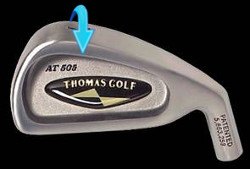
In the context of golf clubs, “camber” typically refers to the curvature or shape of the sole of the clubhead. The camber of a golf club affects how the club interacts with the ground during a swing.
Camber on a club is most commonly discussed in relation to irons and wedges. The sole of these clubs is often designed with a slight curve from the leading edge to the trailing edge, which helps with turf interaction.
The purpose of camber on a club is to prevent the clubhead from digging too much into the ground, particularly on shots where the club strikes the ground before making contact with the ball (such as iron shots). The camber allows the club to glide smoothly over the turf, reducing the likelihood of the clubhead getting stuck and causing a fat or heavy shot.
The amount of camber on a club's sole can vary depending on the club's design, the playing conditions, and the golfer's preference. Some players may prefer more camber for better turf interaction, while others may prefer less camber for a more versatile club that can handle different lies.
It's worth noting that the concept of camber can also apply to other types of clubs, such as fairway woods and drivers, although to a lesser extent. These clubs may have a shallow camber or a flatter sole to promote better contact with the ground and minimize the chance of the clubhead digging into the turf.
Understanding the camber of a golf club is important for golfers as it can affect how the club performs on different types of lies and the overall playability of the club.
The curvature on the sole of a golf club – from heel to toe and front to back — is called camber. This shape helps the club glide more smoothly over the ground while reducing the digging effect, especially on irons. Woods and hybrids are also cambered.





